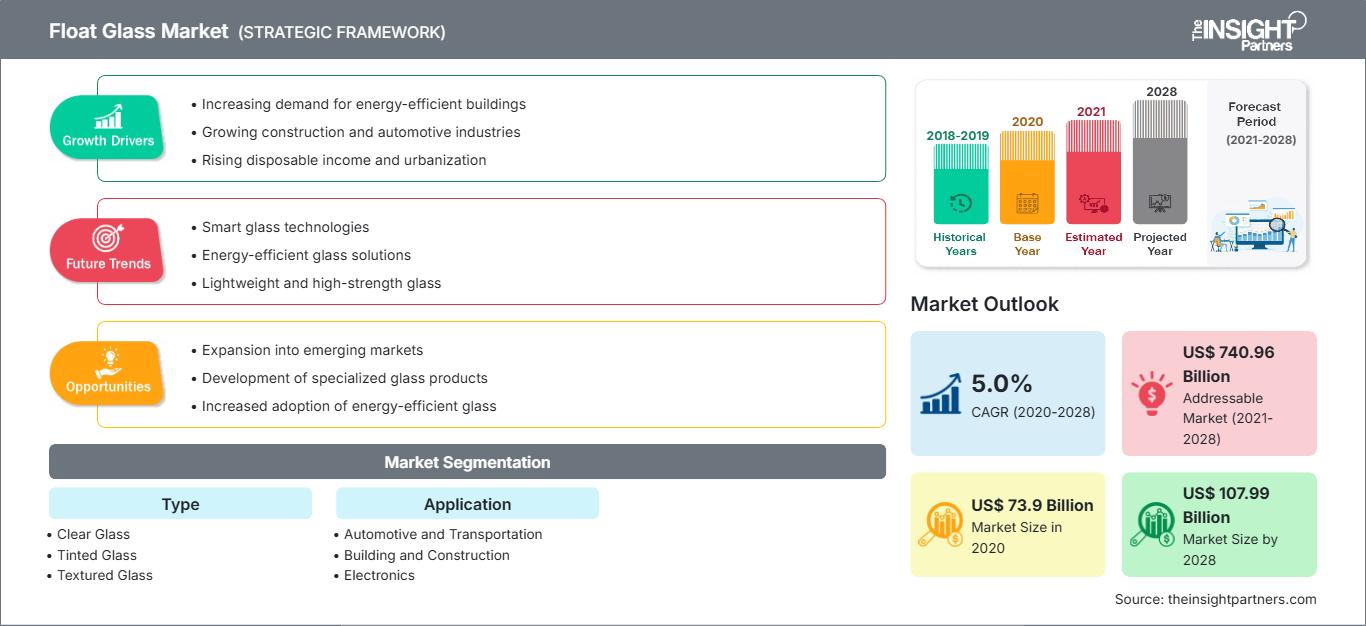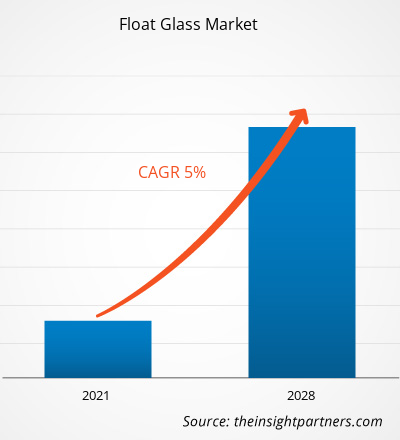Le marché du verre flotté était évalué à 73 897,83 millions de dollars américains en 2020 et devrait atteindre 1 07 991,35 millions de dollars américains d'ici 2028 ; il devrait croître à un TCAC de 5,0 % entre 2021 et 2028.
Le verre flotté est un verre extrêmement lisse et sans distorsion, utilisé dans diverses industries finales telles que le bâtiment et la construction, l'automobile, l'électronique, l'énergie solaire, entre autres. Il est essentiellement fabriqué en versant le verre fondu du four dans une chambre contenant un lit d'étain fondu. L'augmentation de l'utilisation du verre flotté dans la décoration intérieure et l'architecture moderne a joué un rôle majeur dans l'augmentation de la demande de verre flotté. Il est utilisé dans d'autres applications du bâtiment et de la construction, notamment les plafonds, les revêtements de sol, les fenêtres réfléchissantes, les revêtements de sol, les miroirs, les dessus de table et le verre isolant. De plus, l'utilisation croissante du verre flotté dans les applications automobiles devrait stimuler l'industrie du verre flotté au cours de la période de prévision.
En 2020, l'Asie-Pacifique représentait la plus grande part du marché mondial du verre flotté. Le développement croissant des secteurs automobile et du bâtiment et de la construction stimule la demande de verre flotté dans la région. L'importante implantation du secteur automobile dans des pays comme la Chine et l'Inde accroît également la demande de verre flotté dans ces pays. Parallèlement, le développement et la pénétration croissante de l'industrie solaire en Asie-Pacifique stimulent la croissance du marché du verre flotté dans la région.
Personnalisez ce rapport en fonction de vos besoins
Vous bénéficierez d’une personnalisation sur n’importe quel rapport - gratuitement - y compris des parties de ce rapport, ou une analyse au niveau du pays, un pack de données Excel, ainsi que de profiter d’offres exceptionnelles et de réductions pour les start-ups et les universités
Marché du verre flotté: Perspectives stratégiques

-
Obtenez les principales tendances clés du marché de ce rapport.Cet échantillon GRATUIT comprendra une analyse de données, allant des tendances du marché aux estimations et prévisions.
La fermeture de plusieurs usines de fabrication en Amérique du Nord, en Europe, en Asie-Pacifique, en Amérique du Sud, au Moyen-Orient et en Afrique en raison de la pandémie de COVID-19 a entravé la chaîne d'approvisionnement mondiale, les processus de fabrication, les délais de livraison et les ventes de produits. De plus, les restrictions imposées par les pays d'Europe, d'Asie et d'Amérique du Nord affectent la collaboration commerciale et les opportunités de partenariat. La pandémie de COVID-19 en cours a eu un impact significatif sur le marché du verre flotté. Les perturbations de la production et de la chaîne d'approvisionnement ont eu un impact négatif sur le marché du verre flotté. La pénurie de verre devrait durer jusqu'en 2021, entraînant des perturbations dans diverses entreprises. L'offre de verre se resserre et son coût d'achat est devenu plus élevé en raison de divers problèmes, notamment la pandémie mondiale et les tarifs internationaux. En raison de la pandémie mondiale, de nombreuses usines et fabricants ont dû suspendre ou ralentir leur production de verre, ce qui rend extrêmement difficile la satisfaction de la demande actuelle. Redémarrer les usines après une fermeture ou une production à faible intensité pendant une période prolongée peut s'avérer extrêmement difficile, surtout si les entreprises ne fonctionnent pas à pleine capacité en raison des réglementations sanitaires. De plus, la vaccination contre la COVID-19 étant une priorité absolue pour le public et le secteur de la santé, la disponibilité du verre a été réorientée vers la cause, ce qui a entraîné l'indisponibilité du verre pour d'autres industries, créant ainsi une pénurie de verre sur le marché.
Analyses du marché
Augmentation de la demande du secteur du bâtiment et de la construction
Le verre flotté est fabriqué par un procédé de fusion où du verre recyclé, de la chaux, du sable de silice, de la potasse et de la soude sont fondus dans un four et flottés sur un lit d'étain fondu. Le verre flotté est de plus en plus utilisé dans le secteur du bâtiment et de la construction, qui comprend les secteurs résidentiel, commercial et industriel. Le verre flotté présente une excellente transmission lumineuse, une grande variété de couleurs et d'opacités, ainsi qu'une bonne inertie chimique, ce qui a accru sa demande dans le secteur de la construction. Utilisé pour les fenêtres et les portes dans le secteur résidentiel, il offre des applications à la fois esthétiques et fonctionnelles. Il est également de plus en plus utilisé en décoration intérieure et en architecture moderne. Dans le secteur commercial, le verre flotté est très recherché car il offre une surface extérieure esthétique et facile d'entretien. Il offre une bonne transmission de la lumière et de la chaleur, influençant les besoins de chauffage et de climatisation d'un bâtiment selon les saisons et les climats. Il est également utilisé comme vitrine dans les commerces de détail grâce à sa transparence, sa dureté et sa facilité de nettoyage. Face aux préoccupations environnementales croissantes, la demande de verre flotté dans le secteur de la construction a augmenté, car il contribue à l'obtention de la certification LEED (Leadership in Energy and Environment Design) pour les constructions résidentielles et commerciales. La sensibilisation croissante des consommateurs à la sécurité des bâtiments et l'attention accrue portée au respect des normes de construction gouvernementales devraient encore accroître la demande de verre flotté. Ainsi, la demande croissante de verre flotté dans le secteur du bâtiment et de la construction alimentera la croissance du marché du verre flotté au cours de la période de prévision.
Aperçu des types
Le marché du verre flotté est segmenté en fonction du type : verre clair, verre teinté, verre texturé, etc. Le segment du verre clair détenait la plus grande part de marché en 2020. Le verre clair est un verre flotté transparent et exempt de défauts et de distorsions optiques. Le verre flotté clair offre une qualité supérieure à celle des autres types de verres flottés grâce à ses caractéristiques uniques, telles qu'une finition de surface améliorée, une épaisseur uniforme, une qualité optique élevée, une planéité et un aspect brillant. Il est utilisé dans les zones nécessitant une visibilité et une clarté élevées, telles que les fenêtres, les portes, les miroirs, les serres, les puits de lumière, les appareils électroménagers et les solariums. Le verre clair étant exempt de toute distorsion optique ou de petits défauts, il offre une vue parfaite. Le verre est également utilisé pour des transformations ultérieures afin de produire d'autres types de verre.
Parmi les principaux acteurs du marché du verre flotté, on trouve : AGC Inc. ; Nippon Sheet Glass Co., LTD (NSG Group) ; Xinyi Glass Holdings Limited ; SCHOTT AG ; Guardian Industries Holdings ; Cardinal Glass Industries, Inc. ; China Glass Holdings Limited ; Shenzhen Sun Global Glass Co. Ltd. ; Saint Gobain Glass India ; et Qingdao Migo Glass Co. Ltd. Les principaux acteurs du marché adoptent des stratégies telles que les fusions et acquisitions et les lancements de produits pour étendre leur présence géographique et leur clientèle.
Marché du verre flottéLes tendances régionales et les facteurs influençant le marché du verre flotté tout au long de la période de prévision ont été analysés en détail par les analystes de The Insight Partners. Cette section aborde également les segments et la géographie du marché du verre flotté en Amérique du Nord, en Europe, en Asie-Pacifique, au Moyen-Orient et en Afrique, ainsi qu'en Amérique du Sud et en Amérique centrale.
Portée du rapport sur le marché du verre flotté| Attribut de rapport | Détails |
|---|---|
| Taille du marché en 2020 | US$ 73.9 Billion |
| Taille du marché par 2028 | US$ 107.99 Billion |
| TCAC mondial (2020 - 2028) | 5.0% |
| Données historiques | 2018-2019 |
| Période de prévision | 2021-2028 |
| Segments couverts |
By Type
|
| Régions et pays couverts |
Amérique du Nord
|
| Leaders du marché et profils d'entreprises clés |
|
Densité des acteurs du marché du verre flotté : comprendre son impact sur la dynamique commerciale
Le marché du verre flotté connaît une croissance rapide, portée par une demande croissante des utilisateurs finaux, due à des facteurs tels que l'évolution des préférences des consommateurs, les avancées technologiques et une meilleure connaissance des avantages du produit. Face à cette demande croissante, les entreprises élargissent leur offre, innovent pour répondre aux besoins des consommateurs et capitalisent sur les nouvelles tendances, ce qui alimente la croissance du marché.
- Obtenez le Marché du verre flotté Aperçu des principaux acteurs clés
Points forts du rapport
- Tendances progressives dans l'industrie du verre flotté pour aider les acteurs à développer des stratégies efficaces à long terme
- Stratégies de croissance adoptées par les entreprises pour assurer la croissance sur les marchés développés et en développement
- Analyse quantitative du marché mondial du verre flotté de 2019 à 2028
- Estimation de la demande de verre flotté dans divers secteurs
- Analyse de Porter pour illustrer l'efficacité des acheteurs et des fournisseurs opérant dans l'industrie pour prédire la croissance du marché
- Évolutions récentes pour comprendre le scénario concurrentiel du marché et la demande de verre flotté
- Tendances et perspectives du marché associées aux facteurs qui stimulent et freinent la croissance du marché du verre flotté
- Compréhension des stratégies qui sous-tendent l'intérêt commercial concernant la croissance du marché mondial du verre flotté, aidant au processus de prise de décision
- Taille du marché du verre flotté à différents nœuds Marché
- Aperçu détaillé et segmentation du marché mondial du verre flotté ainsi que de sa dynamique industrielle
- Taille du marché du verre flotté dans diverses régions avec des opportunités de croissance prometteuses
Marché du verre flotté, par type
- Verre transparent
- Verre teinté
- Verre texturé
- Autres
Marché du verre flotté, par application
- Automobile et transport
- Bâtiment et construction
- Électronique
- Autres
Profils d'entreprise
- AGC Inc.
- Nippon Sheet Glass Co., LTD (NSG Group)
- Xinyi Glass Holdings Limited
- SCHOTT AG
- Guardian Industries Holdings
- Cardinal Glass Industries, Inc.
- China Glass Holdings Limited
- Shenzhen Sun Global Glass Co. Ltd.
- Saint Gobain Glass India
- Qingdao Migo Glass Co. Ltd
- Analyse historique (2 ans), année de base, prévision (7 ans) avec TCAC
- Analyse PEST et SWOT
- Taille du marché Valeur / Volume - Mondial, Régional, Pays
- Industrie et paysage concurrentiel
- Ensemble de données Excel
Rapports récents
Rapports connexes
Témoignages
Raison d'acheter
- Prise de décision éclairée
- Compréhension de la dynamique du marché
- Analyse concurrentielle
- Connaissances clients
- Prévisions de marché
- Atténuation des risques
- Planification stratégique
- Justification des investissements
- Identification des marchés émergents
- Amélioration des stratégies marketing
- Amélioration de l'efficacité opérationnelle
- Alignement sur les tendances réglementaires






















 Obtenez un échantillon gratuit pour - Marché du verre flotté
Obtenez un échantillon gratuit pour - Marché du verre flotté